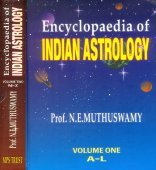Natural phenomenon, Natural phenomena: 2 definitions
Introduction:
Natural phenomenon means something in Hinduism, Sanskrit. If you want to know the exact meaning, history, etymology or English translation of this term then check out the descriptions on this page. Add your comment or reference to a book if you want to contribute to this summary article.
In Hinduism
Natyashastra (theatrics and dramaturgy)
Source: Shodhganga: Elements of Art and Architecture in the Trtiyakhanda of the Visnudharmottarapurana (natya)1) Natural phenomena are associated with Patāka-hasta: one of the twenty-two Single-hand Gestures (in Indian Dramas) (known as asaṃyuktahastas), according to the Viṣṇudharmottarapurāṇa, an ancient Sanskrit text which (being encyclopedic in nature) deals with a variety of cultural topics such as arts, architecture, music, grammar and astronomy.—The word patāka indicates dhvaja in Sanskrit which means flag or banner. [...] In the Abhinayadarpaṇa, it is said that the patākahasta is used to denote the beginning of a drama. Moreover, this hand posture is used to symbolize some natural phenomenon like cloud, forest, bosom, river, wind etc.
2) Natural phenomena (like day and night) are also associated with Sūcyāsyahasta: another one of the twenty-two Single-hand Gestures.—The word sūcī means a tool which is used for stitching. It refers to the needle. [...] The Viṣṇudharmottarapurāṇa says that the natural phenomenon like day and night are denoted with this hand posture. It is also used to denote the eyes of Śakra and Maheśa.

Natyashastra (नाट्यशास्त्र, nāṭyaśāstra) refers to both the ancient Indian tradition (shastra) of performing arts, (natya—theatrics, drama, dance, music), as well as the name of a Sanskrit work dealing with these subjects. It also teaches the rules for composing Dramatic plays (nataka), construction and performance of Theater, and Poetic works (kavya).
Shilpashastra (iconography)
Source: Shodhganga: Elements of Art and Architecture in the Trtiyakhanda of the Visnudharmottarapurana (shilpa)Natural phenomenon (like day and night) follows specific guidelines in the tradition of ancient Indian Painting (citra), according to the Viṣṇudharmottarapurāṇa, an ancient Sanskrit text which (being encyclopedic in nature) deals with a variety of cultural topics such as arts, architecture, music, grammar and astronomy.—From the ancient period till today, many natural objects and natural phenomenon (like day and night, etc.) always seem to inspire the artist to make beautiful creations. Even the sages in the Vedic period used to see the surroundings and could visualise everything as portraits in the mind. The Viṣṇudharmottarapurāṇa also bears an elaborate description on the process of making the picture of some natural objects and phenomenon. In the Vedic period, some natural objects and phenomena were associated with the form of deities.

Shilpashastra (शिल्पशास्त्र, śilpaśāstra) represents the ancient Indian science (shastra) of creative arts (shilpa) such as sculpture, iconography and painting. Closely related to Vastushastra (architecture), they often share the same literature.
See also (Relevant definitions)
Partial matches: Natural.
Query error!
Full-text (+22): Upalinga, Upaplava, Daivatyaya, Ajanya, Arishta, Gatividhi, Day, Night, Ritudharmashastra, Forest, River, Rugveda, Gandharvapura, Gandharvanagara, Upatta, Wind, Rigveda, Sa-bhuta-vata-pratyaya, Moon-light, Cloud.
Relevant text
Search found 118 books and stories containing Natural phenomenon, Natural phenomena; (plurals include: Natural phenomenons, Natural phenomenas). You can also click to the full overview containing English textual excerpts. Below are direct links for the most relevant articles:
The concept of Vaishvanara in Vedic literature (by Satyanarayan Rath)
2. Parenthood of the Vedic gods < [Chapter 1 - Introduction]
1. Prolouge (to the Vedic concept of nature) < [Chapter 3 - The natural concept of Vaiśvānara]
4. Vaiśvānara as Celestial Fire < [Chapter 3 - The natural concept of Vaiśvānara]
Significance of the Moon in Ancient Civilizations (by Radhakrishnan. P)
2. Illustration of Mind < [Chapter 7 - Moon the Significant Planet of Mind]
1. Manifested Deities of Planets < [Chapter 15 - Conclusion]
5. Iconography of Moon < [Chapter 2 - A Sceintific Outlook on Astrology]
Values of Life: From Darkness to Light < [January – March, 1978]
Krishnaism or The Vishnu-Cult < [July 1953]
Encounter with Absolute < [October – December, 1981]
Maha Buddhavamsa—The Great Chronicle of Buddhas (by Ven. Mingun Sayadaw)
Part 10d - The method of fulfilling the Perfection of Wisdom (Paññā Pāramī) < [Chapter 7 - On Miscellany]
Part 9 - What are the Factors that oppose the Pāramīs? < [Chapter 7 - On Miscellany]
Notes (b): Why is it Called Morality? < [Chapter 6 - On Pāramitā]
Devi Tantra, Mantra, Yantra (study) (by Srider Basudevan Iyer)
Introduction to the Minor goddesses < [Chapter 3 - Minor Goddesses]
Description of Goddesses Usas < [Chapter 3 - Minor Goddesses]
Description of Goddesses Sandhya (or Twilight) < [Chapter 3 - Minor Goddesses]
Vedic influence on the Sun-worship in the Puranas (by Goswami Mitali)
Part 8 - The Concept of God in the Light of the Vedas < [Chapter 1 - Vedic Concept of God and Religion]
Part 1 - Eulogy of the Sun-god in the Purāṇas < [Chapter 4 - Vedic Influence on the Sun-Worship in the Purāṇas]
Part 5 - The principal theories deal with the origin and evolution of religion < [Chapter 1 - Vedic Concept of God and Religion]
Related products

